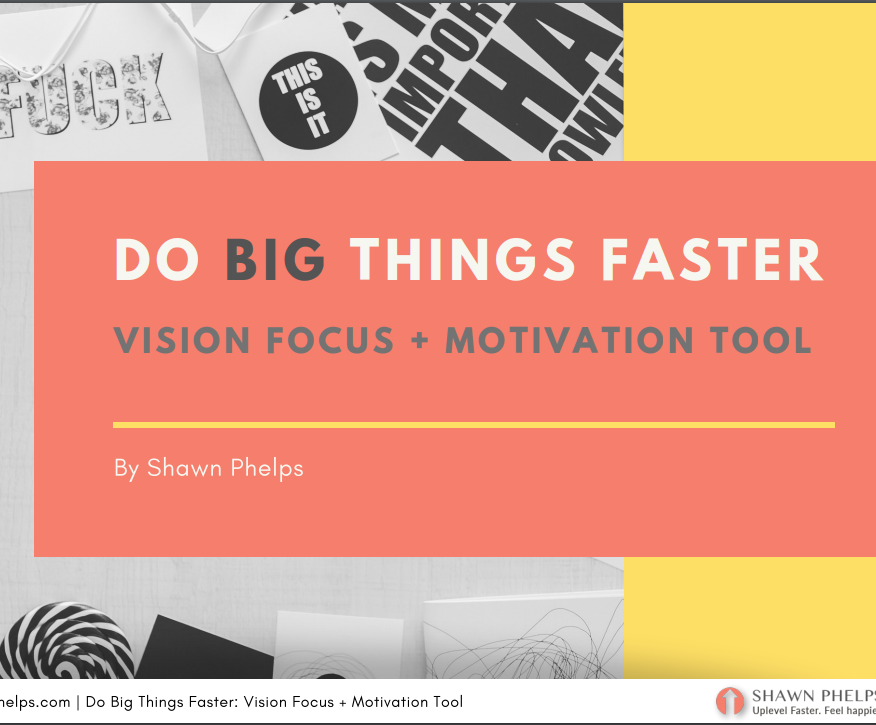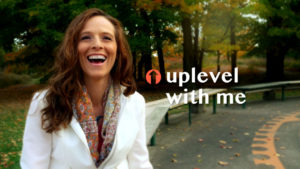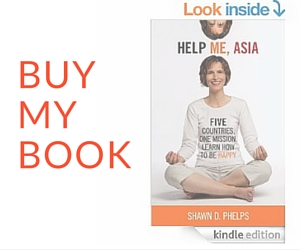You wake up and…what’s that?
A vaguely uncomfortable (or, perhaps, distinctly awful) feeling that you immediately want to get rid of.
No worries. You drown it with coffee, maybe even distract yourself with mantra meditations but, a few hours later, you notice it’s still there. You tell yourself you’re just bored, or restless. Maybe you need a “new” thing: a lover, job, hobby, TV series, iPhone.
But that won’t solve the problem. I’m going to share my formula that will.
First, A Little About Uncomfortable Feelings
It’s true, what they say, that feelings are created by thoughts. But whose thoughts? The adult version of you, or the child version of you?
I’ve been studying emotions for two decades in myself and others. Here’s what I’ve learned: most of our “uncomfortable” emotions can be traced back to our formative experiences. When our True Self was not fully valued or supported—and it very rarely is in our society, which is based in comparison, competition and shaming—the child version of us rightly felt that his or her emotional needs were not being met (here’s a top-10 list of children’s emotional needs and Maslow’s Hierarchy of Needs in case you’re curious to see if all your needs were met. I already know they weren’t; because if they were you wouldn’t be reading this).
When these needs were not met, limiting beliefs were created. These beliefs construct knots in your subconscious energy system. They also secretly generate painful thoughts and feelings that you may or may not be consciously aware of. Something super interesting I’ve discovered is that these feelings are always held in place by secondary feelings. Yeah, crazy! Don’t worry, you’ll understand this more clearly in just a moment.
“But, wait!” you say, “This doesn’t apply to me at all. This emotion I’m having today doesn’t come from my childhood. My childhood was fine. It was caused by the crappy weather, or by what someone said to me yesterday.”
No. It was “triggered” by the crappy weather, or by what someone said yesterday. And you can only trigger something that already exists inside of you.
As far as your childhood being “fine”, remember a child’s view of needs are not the same as an adult’s view—and it was the child version of you who made those emotion-based decisions on what needs he/she felt were and weren’t being met that formed those limiting beliefs. Soooo, it has way more to do with perception than reality. For now, you’re stuck with the leftover emotions from those perceptions.
But no worries! We’re gonna fix that soon.
Why Emotions Get Stuck
So, while uncomfortable emotions are originally created by thoughts, they get trapped in place by “other” feelings.
Yep, emotions can become “imprisoned” inside of you.
While we may think our problem is with fear, anxiety or anger, that emotion is usually hiding another “heavier” emotion underneath—often grief/sadness, guilt, shame. Of those emotions, shame is the heaviest and can do the most damage to the psyche, so it is usually the most buried.
These secondary emotions create resistance and hold the original emotion in “prison”. The sadness is literally imprisoned by anger, or whatever. And the only way to set it free, so it can naturally move through and be processed, is to understand and shift the resisting emotion.
The reason why this happens? While one part of us is sad, another part believes that it’s dangerous or unacceptable to feel sad so it tries to protect us with anger, anxiety etc. Your amygdala, the primitive part of your brain, cares only about one thing—your survival. If it gets the message from your caregivers or society that sadness, etc. is unacceptable, it will bury it under a more “acceptable” and “actionable” emotion, such as “anger”.
Anyway, enough about all this. Here’s the solution.
You’re going to need a pen and paper.
My Formula:
6 Steps to Break Out of Emotional Prison
(An Inner Adventure!)
1. Feeling 1: Identify what you’re feeling (angry, sad, etc.) about a situation. “When this happens I feel X” (e.g. When I think about all the things I want to do, and see that I’m not doing them, I feel sad.)
2. Feeling 2: Identify how you feel in response to that feeling? (e.g.When I feel sad I feel angry, because I don’t want to feel sad.)
3. Interpretations: What do you interpret “feeling 1” to mean about you that is making you feel “feeling 2”. (e.g. Because I interpret sadness to mean I’m worthless and useless.)
4. Identify the limiting belief hidden in this interpretation: e.g. “Sad people are worthless and useless.”
5. Find the root cause. Think back to your childhood to see if anything happened, or anyone said anything to you, or if you saw anything around you that would create this belief. If you can’t find it, just get started with step 6 and trust it will show up eventually.
Bonus 1: Identify the unmet need that created this belief: i.e. to be able to safely express my feelings, and feel that I’m okay even when I’m sad.) Again, a list of our top 10 needs can be seen here.
Bonus 2: Ask yourself: What is the payoff of continuing to believe “X” (e.g. that sad people are worthless and useless). Don’t answer from your head; go inside and listen to what your heart has to say. (When I asked my heart, it said that it keeps me “small and safe”.)
6. Get rid of that sucker. Now that you know the belief and you know its root cause, you can go straight to Youtube and do some EFT on it. Here’s an EFT primer with Brad Yates (he’s my fav). You could also try my Emotional Awareness meditation. It’s a form of mindfulness-style meditation, which creates space around the resisting emotions so they can shift. I usually use these together, for a powerful 1-2 punch. The more you can “be with” the uncomfortable emotion while tapping on it, and the belief that created it, the more easily you will clear it.
(You can cut and paste the formula below into your Evernote, Google Docs or whatever to try it out.)
The Formula in Action
When I think about_________, I feel_________.
When I feel_________(feeling 1), I feel_________(feeling 2) because_______________.
I feel_________(feeling 2) because I interpret_________(feeling 1) to mean that I am_____________________.
My limiting belief is:________________________________________
The root cause of this belief is:_________________________________
The unmet need that created this belief is:____________________________________________
What’s the payoff of continuing to believe in this limiting belief?______________________________________________________________
Here’s My Example (yeppir, most of us are secretly thinking shitty things about ourselves!)
When I think about: all the things I want to do, and see that I’m not doing them, I feel sad (feeling 1).
When I feel sad (feeling 1), I feel angry (feeling 2) because I don’t want to feel sad.
I feel angry because I interpret sadness to mean I am worthless, lazy and useless (there’s a toxic mess for ya).
Limiting belief: sad people are worthless, lazy and useless.
Root cause: When I cried or acted sad as a child, my father would yell at me. (Interestingly, he never called me “worthless, lazy or useless”, but I overheard him using those words to describe others and I concluded he must also feel that way about me.) Childhood beliefs are tricky that way; they are always more about a child’s perception than reality.
The unmet need that created this belief: to be able to safely express my feelings, and feel that I’m okay even when I’m sad.
The payoff for continuing to believe in this limiting belief: it keeps me small and “safe”. (It’s hard to clear the limiting belief if you don’t know the “crazy glue” belief that has kept it stuck in place. My experience is that it’s usually related to safety, because that is our False Self’s primary concern.)
Celebrate!
Uncovering this limiting belief was one of my greatest discoveries so far—on par with the day I found an opal while noodling in Coober Pedy, Australia. It’s a wonderful thing because, once you find it, it’s fairly easy to begin clearing it. Remember, these “knots” in your energy system don’t want to be there. Clear the limiting belief and you’ll clear a bunch of uncomfortable emotions at once (all those layers, remember?). As soon as you notice these beliefs (and connected feelings) and bring loving awareness to them, they’ll begin shifting on their own.
I just found and shifted another good one this morning: “The future is dangerous.” After a few rounds of EFT, I’ve shifted it to: “I don’t know what the future holds. It might be dangerous, but there’s an equal or greater chance that it will be wonderful.” Much less panic. And where did I find that belief? It was hiding underneath “I am not enough.” (What’s the payoff of believing I’m not enough? The answer was: It keeps me small and safe because “the future is dangerous”). Fascinating or what?
Enjoy your inner adventure! (Yes, I AM serious. Or crazy, no one’s sure which, yet. But I honestly feel that if you’re gonna go in and dig around, you might as well try to enjoy it.)
Aaaaand, now that you know the kind of crap I’m healing in myself (and how excited I am about doing it), don’t be shy! We don’t need to feel ashamed of this stuff; we all have it and the sooner we clear it, the sooner we’ll experience more of what we want. If you try this out, let us know what happened in the comments section below!

- It taps you into your purpose + life's calling.
- This gives you focus + motivation + momentum.
- It comes with a video tutorial + mini-course.
- + 6 days of life-changing secrets on harnessing the power of your subconscious mind to do bigger things faster + happier.


